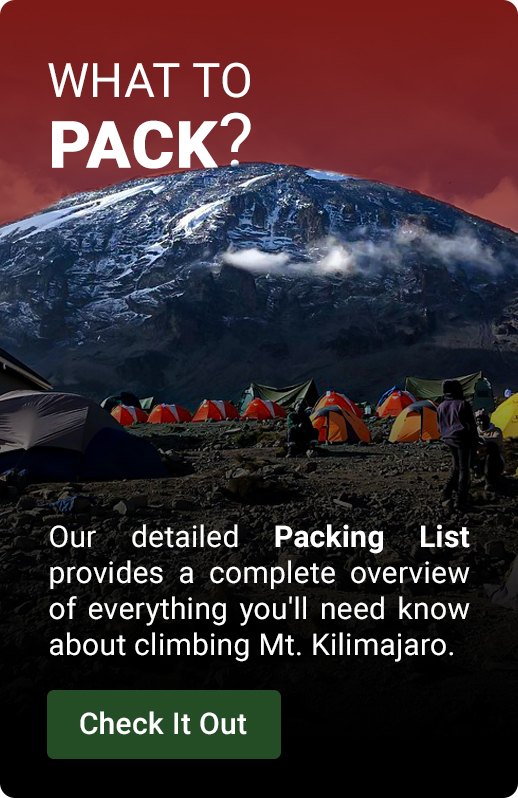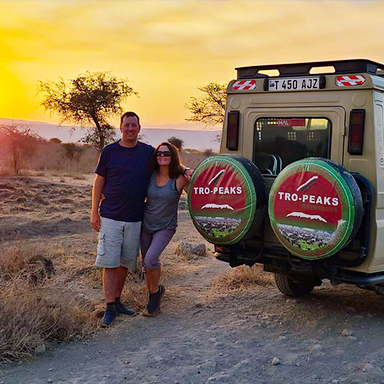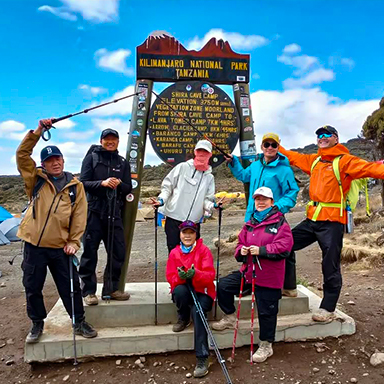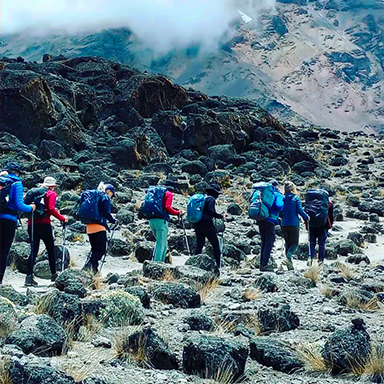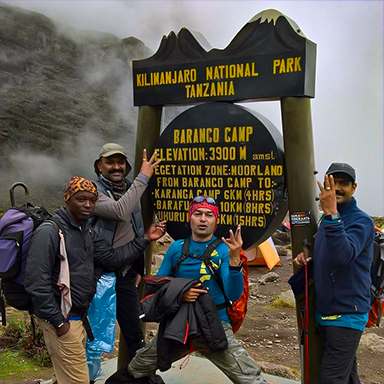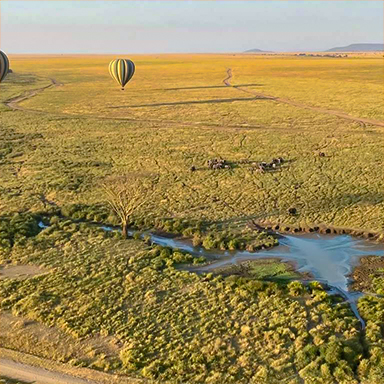Trekking Mount Kilimanjaro & Other Mountains
Frequent Asked Questions
Our constant goal is to provide accurate, current, useful, and engaging information. Our staff of mountain specialists provides firsthand knowledge and perspectives on Kilimanjaro and other well-known hiking locations.
Popular Questions About Kilimanjaro
Where is Mount Kilimanjaro located?
Mount Kilimanjaro lies just three degrees south of the equator. All trailheads are in Tanzania, even though some of the most famous panoramic views of Mount Kilimanjaro have been taken from the Kenyan side. As a result, tourists can only climb Mt Kilimanjaro in Tanzania. The closest airport is Kilimanjaro International Airport.
How do I get to Mt Kilimanjaro?
Fly directly to Kilimanjaro
The most convenient option is to fly directly into Kilimanjaro International Airport. From there, it's just a few hours by car to the base of Africa's highest peak. We highly recommend this direct-flight option as it gives you more time to recover from your journey and rest before the climb.
Through Dar es Salaam and local flight to Kilimanjaro
Another option is to fly into Dar es Salaam on an international flight and then take a local flight to Kilimanjaro. While this might initially seem cheaper, it's important to consider the additional cost of the flight to Kilimanjaro and the baggage limitations on local airlines, which often come with extra fees for overweight luggage.
Through Nairobi and overland ride to Kilimanjaro
Finally, you can fly into Nairobi, Kenya, and then take a bus to Tanzania. This option might offer the lowest airfare, but keep in mind the added costs of a Kenyan transit visa and the transfer to Moshi. If there are no delays at the border, the bus journey takes about six hours.
The most convenient option is to fly directly into Kilimanjaro International Airport. From there, it's just a few hours by car to the base of Africa's highest peak. We highly recommend this direct-flight option as it gives you more time to recover from your journey and rest before the climb.
Through Dar es Salaam and local flight to Kilimanjaro
Another option is to fly into Dar es Salaam on an international flight and then take a local flight to Kilimanjaro. While this might initially seem cheaper, it's important to consider the additional cost of the flight to Kilimanjaro and the baggage limitations on local airlines, which often come with extra fees for overweight luggage.
Through Nairobi and overland ride to Kilimanjaro
Finally, you can fly into Nairobi, Kenya, and then take a bus to Tanzania. This option might offer the lowest airfare, but keep in mind the added costs of a Kenyan transit visa and the transfer to Moshi. If there are no delays at the border, the bus journey takes about six hours.
When are the rainy and the dry seasons in Tanzania?
Tanzania has two rainy seasons and two dry seasons. The short rainy season begins in early November and lasts until late December. It is followed by the dry season, which lasts until mid-March. Then the season of long rains begins, ending in mid-June.
You should consider the northern slopes to climb Kilimanjaro during the rainy season. According to the data we received from the Tanzania Meteorological Authority, this part of the mountain receives five times less rainfall. Good Kilimanjaro routes to choose from are Rongai, Northern Circuit, and Marangu.
One should also remember that the period from June to October in East Africa is marked by cold nights. At the high altitudes of Kilimanjaro, the nights will be pretty chilly. Make sure you have everything from our packing list.
You should consider the northern slopes to climb Kilimanjaro during the rainy season. According to the data we received from the Tanzania Meteorological Authority, this part of the mountain receives five times less rainfall. Good Kilimanjaro routes to choose from are Rongai, Northern Circuit, and Marangu.
One should also remember that the period from June to October in East Africa is marked by cold nights. At the high altitudes of Kilimanjaro, the nights will be pretty chilly. Make sure you have everything from our packing list.
How tall is Mount Kilimanjaro?
Uhuru Peak, the summit of Mount Kilimanjaro, stands tall at 5,895 meters (19,341 feet). Yet, this doesn't mean you'll be starting your climb from the very base. Most hotels near Kilimanjaro are at an altitude of 700-1,000 meters above sea level. The trailheads begin at elevations of 1,600 meters and above.
Due to its altitude, Mt Kilimanjaro is among the few places in East Africa to see snow. The snow-capped peak of Kilimanjaro is truly a sight to behold!
Due to its altitude, Mt Kilimanjaro is among the few places in East Africa to see snow. The snow-capped peak of Kilimanjaro is truly a sight to behold!
Can you climb Mount Kilimanjaro without a guide?
Climbing Kilimanjaro is subjected to the regulations of the Kilimanjaro National Park. The official rules dictate that a local guide must accompany all hikers. Rangers at the park will not permit entry to anyone without a professional Kilimanjaro guide.
Also, venturing up to the Roof of Africa solo involves certain risks. During the summit night in the peak zone, one may succumb to altitude sickness or get injured. If needed, the guides will assist with evacuations and other emergencies.
Finally, climbing Kilimanjaro is more than merely a physical challenge. On this journey, you will learn about Kilimanjaro's plants, animals, history, and traditions. The guides will also share vibrant stories of the communities living in the shadow of the mountain.
Also, venturing up to the Roof of Africa solo involves certain risks. During the summit night in the peak zone, one may succumb to altitude sickness or get injured. If needed, the guides will assist with evacuations and other emergencies.
Finally, climbing Kilimanjaro is more than merely a physical challenge. On this journey, you will learn about Kilimanjaro's plants, animals, history, and traditions. The guides will also share vibrant stories of the communities living in the shadow of the mountain.
Can a beginner climb it?
Yes, Kilimanjaro is accessible to beginners with little or no trekking experience. With some prior training and a good climbing tour, your chances of conquering Kilimanjaro will be very high.
How should I train for the climb?
Maintaining a reasonable level of fitness is crucial to climb Kilimanjaro. However, summiting Kilimanjaro doesn't require athletic prowess. A healthy average would be adequate. As a guideline, we suggest assessing whether you can comfortably hike 8-10 km (5-6.2 mi) or jog for 4-5 km (2.5 - 3.1 miles). If you can do it, then you are fit enough to climb Mount Kilimanjaro.
Swimming is an excellent complement. Swimming strengthens your entire body and improves your heart and lung endurance. This makes it a great addition to running. The first primarily focuses on leg endurance. Swimming takes it further by engaging the arms, core, and legs at the same time. Water buoyancy is also good for people who want to protect their joints while exercising.
Finally, it is great if you have any rural areas nearby with rough hiking trails. Aim for longer ones, ideally in the 10-15 km (6-10 mi) range. Remember, most of the Kilimanjaro hike will be uphill. So, training over longer distances in the countryside will prepare you for the climb to the Roof of Africa.
Swimming is an excellent complement. Swimming strengthens your entire body and improves your heart and lung endurance. This makes it a great addition to running. The first primarily focuses on leg endurance. Swimming takes it further by engaging the arms, core, and legs at the same time. Water buoyancy is also good for people who want to protect their joints while exercising.
Finally, it is great if you have any rural areas nearby with rough hiking trails. Aim for longer ones, ideally in the 10-15 km (6-10 mi) range. Remember, most of the Kilimanjaro hike will be uphill. So, training over longer distances in the countryside will prepare you for the climb to the Roof of Africa.
When is the best time to climb it?
Late December to early March and mid-June to late October are the best times for a Kilimanjaro climb. This is when the Kilimanjaro weather is nearly ideal.
Although other months have rain, it doesn't mean there are constant heavy showers. Typically, rains begin in the latter half of the day. This allows trekkers a significant window of clear weather every day during the rainy season. There are also days without any rain. Altezza offers discounted climbs during the wet season.
Although other months have rain, it doesn't mean there are constant heavy showers. Typically, rains begin in the latter half of the day. This allows trekkers a significant window of clear weather every day during the rainy season. There are also days without any rain. Altezza offers discounted climbs during the wet season.
What is the best route for acclimatization?
Among the best routes for acclimatization profile are Lemosho, Machame, and Rongai. Consider them, or other itineraries with seven days and more.
Do you need oxygen systems to climb Kilimanjaro?
At the summit of Kilimanjaro, the level of oxygen in the air is roughly half of what it is at sea level. Most climbers can reach Uhuru Peak without using extra oxygen.
Yet, to be on the safe side, we take precautions. On our expeditions, we always have plenty of oxygen tanks. The cost of this service is included in the price of the climb.
Yet, to be on the safe side, we take precautions. On our expeditions, we always have plenty of oxygen tanks. The cost of this service is included in the price of the climb.
Do I need to take a medical kit with me?
During climbing Kilimanjaro expeditions, Our teams carry comprehensive medical kits. On the hikes, we use smaller tactical kits. They contain everything needed to treat injuries, scratches or twisted limbs. Our camp's larger medical kits have medicines for common problems on a Kilimanjaro climb. Such as for nausea, headaches, vomiting, and stomach issues. Those include medications for nausea, headaches, vomiting, and stomach issues, etc. Also, we have lots of oxygen ready to help you prevent altitude sickness when first symptoms arise. Also, we have lots of oxygen ready to help you prevent altitude sickness when first symptoms arise.
The situation is different if you take any prescription medication. It's best to take it with you on your Tanzania trip.
The situation is different if you take any prescription medication. It's best to take it with you on your Tanzania trip.
Can I go on a safari after I climbed Kilimanjaro?
Tanzania offers renowned destinations for all kinds of African adventures. The most popular spots include Serengeti National Park and Ngorongoro Crater. Planning a safari before or after your climb is undoubtedly a great idea. We have a fleet of new safari vehicles and a crew of highly professional driver-guides who will make your safari truly unforgettable!
Safari & More
Contacts
Copyright © 2025 | Developed by 6 Cubes Solutions


